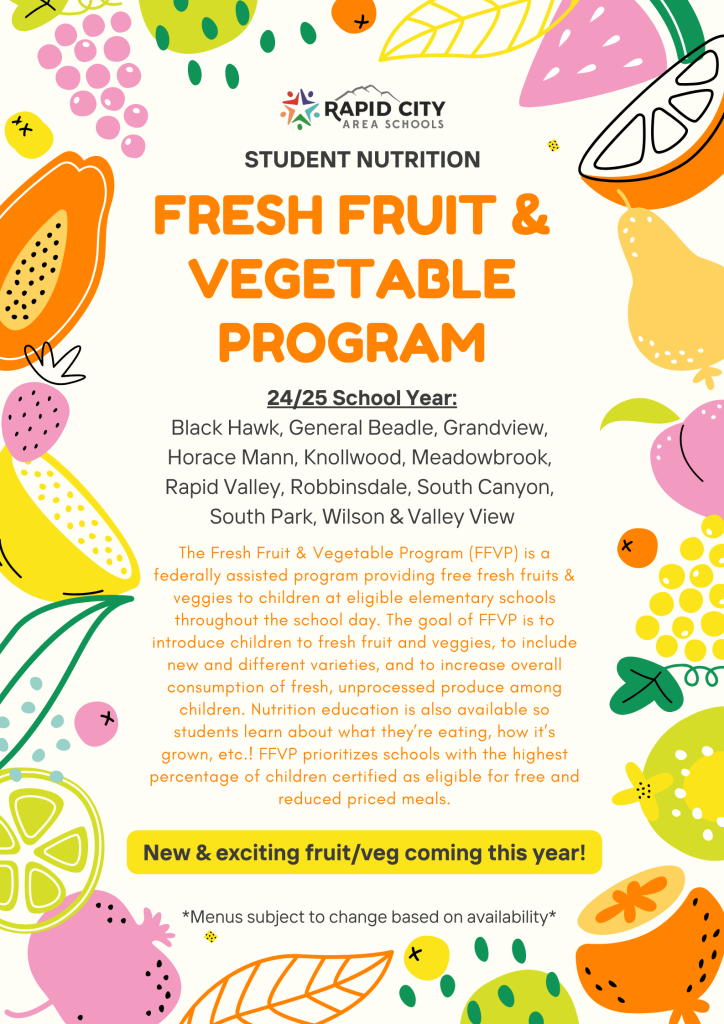Fresh Fruit & Vegetable Program
MENUS
*Subject to change based on availability
November
- 11/4: Baby Bananas
- 11/6: Romanesco
- 11/13: Watermelon Radish
- 11/18: Blood Oranges
- 11/20: Sea Beans
August, September & October
- 8/26: Pineapple – prezi – handout
- 8/28: Rainbow Carrots – prezi – handout
- 9/4: Purple Cauliflower – prezi – handout
- 9/9: Cantaloupe Chunks – prezi – handout
- 9/11: Sugar Snap Peas – prezi – handout
- 9/16: Brown Turkey Figs – prezi – handout
- 9/18: Jicama Sticks – prezi – handout
- 9/23: Watermelon Chunks – prezi – handout
- 9/25: Zucchini Sticks – prezi – handout
- 9/30: Pink Pineapple – prezi – handout
- 10/2: Bell Pepper Mix – prezi – handout
- 10/7: Strawberries – prezi – handout
- 10/9: Candy Beets & Black Radishes – black radish prezi – black radish handout – candy beet prezi – candy beet handout
- 10/16: Grape Tomatoes
- 10/21: Mango Spears
- 10/23: Sweet Potato Sticks
- 10/28: Orange Wedges
- 10/30: Orange Cauliflower
Commonly Asked Questions:
- What is the Fresh Fruit and Vegetable Program? The Fresh Fruit and Vegetable Program (FFVP) is a federally assisted program providing free fresh fruits and vegetables to children at eligible elementary schools during the school day. The goal of the FFVP is to introduce children to fresh fruits and vegetables, to include new and different varieties, and to increase overall acceptance and consumption of fresh, unprocessed produce among children. The FFVP also encourages healthier school environments by promoting nutrition education. To learn more, visit the FFVP webpage: https://www.fns.usda.gov/ffvp/fresh-fruitand-vegetable-program.
- Who administers the FFVP? The Food and Nutrition Service of the United States Department of Agriculture administers the FFVP at the Federal level. At the State level, the FFVP is administered by State agencies, which operate the Program through agreements with local school food authorities. State agency contact information is available at: https://www. fns.usda.gov/school-meals/school-meals-contacts.
- What schools are eligible to participate in the FFVP? Elementary schools in all 50 States, the District of Columbia, and the territories of Guam, Puerto Rico, and the Virgin Islands are eligible to participate. Schools must operate the National School Lunch Program in order to operate the FFVP. Importantly, the FFVP prioritizes schools with the highest percentage of children certified as eligible for free and reduced price meals. This is because children from low-income families generally have fewer opportunities to consume fresh produce on a regular basis.
- What are the requirements for FFVP implementation? Participating elementary schools are required to publicize the availability of the FFVP, and must serve the fresh fruits and vegetables outside the National School Lunch Program and School Breakfast Program meal service times. Beyond these requirements, schools have flexibility in determining their implementation plan. Schools may select the type of produce served, decide the number of days per week to serve the produce (though schools are strongly encouraged to serve a minimum of two days per week), and choose the time outside the breakfast and lunch meal service to provide fresh fruits and vegetables to children.
- What types of fruits and vegetables must be served under the FFVP? The Food and Nutrition Service encourages schools to serve a variety of fresh fruits and vegetables. Because the intent of the FFVP is to introduce children to new and different fresh fruits and vegetables, the produce must be served in a way that it is easily identifiable. This encourages children to enjoy fruits and vegetables “as they are.”
